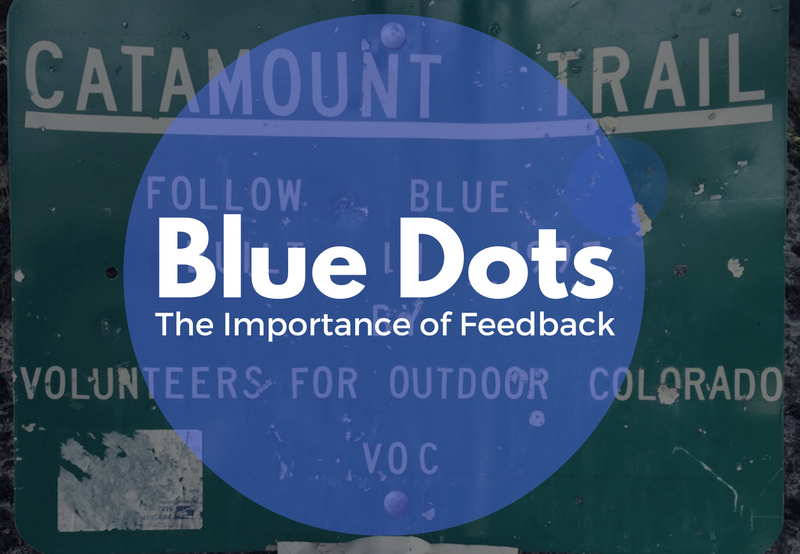
Nobody likes feeling like they are blindly stumbling through their work. Though those trying to forge new paths with their businesses try to train themselves to deal with uncertainty comfortably, most people in most situations want some way to know where they are going and how far they’ve come. They need regular waypoints- guideposts to let them know that their efforts bring progress and that they are pointed in the correct direction to get wherever it is they need to go. They need feedback.
This became clear to me during an episode from my recent vacation; my wife and I were hiking a mountain trail just outside of Colorado Springs, namely the Catamount Trail. I am no expert hiker, despite frequent practice, so I will admit that this intermediate trail posed some difficulty for me- It begins with switchback ridden miles climbing over a steep, rocky and forested slope that promises to open into a beautiful meadow and leads to a hilly stream and reservoir should you surmount the first ridge. Though a native of a mountainous state, I was at an elevation even higher than I was accustomed to hiking, in unfamiliar territory and in for a decent bit of exercise for a big guy with bad knees- I knew it would take a little perseverance if I was going to make the climb in time to see the meadow and get back before I had to hit the road.

Never underestimate the power of a little information at the right time.
This is where the feedback comes in. The dedicated volunteers who had worked on this trail did something that I hadn’t seen in any trail I regularly hike in New Mexico- they installed small signs with color coded dots in crucial locations to help keep you focused on the proper path. They marked our particular path with a bright blue. The trail had many places wherein you could readily lose your way without the markers, from a spiderweb of trails in areas flat enough to explore to rocky outcroppings that don’t show the wear off the hikers that have gone before you- in those areas particularly, the site of a blue dot was enough to confirm your direction and press on.

The trail was clear sometimes, but even then, you couldn’t see it all laid before you.
What surprised me was how much they affected my energy level and enthusiasm. With the dots in place, I felt free to explore the path, and the finding of each blue marker have new a feeling both of accomplishment and of determination to set off toward the next. Each felt like a point of rest and a new beginning, even when I didn’t slow my pace. In one instance, I lost the path in a rocky area, impervious to marks left by foot traffic. Despite being near the ridge, the way was unclear and difficult, and it gave me pause- only after I stopped and surveyed behind me did I see that I had missed a marker behind me, a switchback entirely set on a smooth stone grade; despite my error and losing time and energy to retracing my steps, the marker was a welcome correction.

Each little course correction bolstered my enthusiasm to get to my destination.
As I descended the much less technical path into the valley beyond the ridge, it dawned on me how much that regular feedback, that ping and response, even as passive as it was in the form of simple blue dots, had helped me to make my way through the hike with relative ease and reassured me in the times I was physically pushing my envelope a bit. Unsurprisingly from me, I started to think about how much such feedback can affect our work and the success of our businesses.
Regular feedback is critical to every aspect of our business lives.
From communications with customers throughout the ordering process to the internal processing of jobs, through ensuring the happiness and continued motivation of employees, feedback provides both the drumbeat that sets the pace and the map and compass that lead the way.
For customers, regular feedback in the form of contacts, calls, and status updates assures them that we are paying adequate attention to their needs and that their orders are progressing. Even when setbacks occur, regular feedback and responsive communication through difficulty assures them that we are in control and taking care of their orders. Whether this is personal contacts with in-house customers or even automated emails on status-changes in our eCommerce systems, with customers, feedback elicits trust. Getting feedback from customers helps to reassure salespeople that they have properly understood instructions and allows them to confidently draft instructions for their production staff.

Even a tiny sign that you are on the right track gives you courage to continue.
In order processing, feedback ensures quality and correct, timely execution. When we follow the approval process and include production and salespeople in the feedback loop, we get eyes on the project and we ensure that everyone is on the same page with the way a decoration goes on the garment. When we give appropriate feedback to everyone involved in an order about its status, whether through shop management software or direct communication, every person is able to track progress of an order, and feels confident to tell customers what to expect when they ask for an update. With order processing, feedback helps to keep everyone aligned to the intended look and delivery date for jobs and removes the stress one feels when they can’t honestly tell a customer when their work will be done.

When you know your way and you are eager to see the destination, the going gets easier.
With employees, regular feedback in the form of insightful commentary on job execution, performance, and direction can give a sense of security and purpose. When done properly, even feedback that points to a flaw in an employee’s process can be more reassuring than the uneasy feeling one gets when left entirely to their own devices. It’s important to give employees some autonomy as to how they do their work, but providing them with feedback on their results and showing them how they contribute to the larger purpose that the company serves helps them to feel connected and gives them a sense of where they are headed should they find themselves losing direction. Moreover, getting feedback from employees helps managers understand the conditions on the shop floor and gives them insight both into what they can provide to make production and fulfillment processes smoother. Employees are more motivated when they feel managers are responsive and receptive and when they are given a larger sense of purpose that their work serves and managers feel more confident and able to delegate when they know that employees are committed and attentive.
You can’t underestimate the impact of regular feedback and clear communication. It might be a stretch to get all that from a few blue dots, but the confidence and relief they brought me on the trail is something I know most of us would benefit from greatly as we move through the switchbacks and climbs of our work.








LEAVE A COMMENT